Liquid crystal elastomer (LCE) is known for its geometric, mechanical, magnetic, optical, electrical anisotropy and soft elasticity, and has important significance in stimulus response to shape deformation, sensing, driving and display. In order to control its shape change, it is essential to control the order of liquid crystal (LC) molecules in advance during the formation of the network. Strategies such as applying mechanical force and magnetic or electric field, guiding surface alignment, and shear extrusion are usually used. Cross-linking is performed to lock the mesogen order within the network. Therefore, it is necessary to design a simple but universal strategy.
To this end, Professor Shu Yang’s team from the University of Pennsylvania proposed an entropy control method that prepares complex shapes by directly volatilizing solvents from isotropic liquid crystal network (LCN) organic gels. According to the deformation mode of the organogel during solvent volatilization, different shapes can be erased and reconstructed from the same LCN as needed.The decoupling ability of network synthesis and molecular arrangement relaxes the requirements for LCN chemistry and arrangement methods, allowing various origami structures and passages to be realized3D printingRealize the 4D shape deformation of LCN, which has space and time control. Related work is published on Advanced Materials as a research article entitled “Solvent-Assisted 4D Programming and Reprogramming of Liquid Crystalline Organo-gels”.
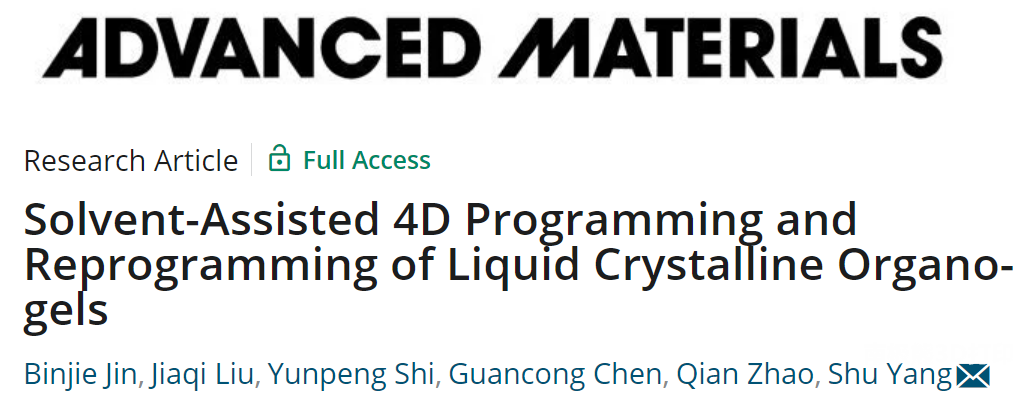
The synthesis of LC organogel and the process of solvent volatilization to form LCN
First, this article creates an isotropic organic gel by cross-linking in a miscible organic solvent to create a thiol-ene precursor. For the LC copolymer synthesized from reactive mesogenic monomer and chain extender propylene dithiol, Rm82 and PDT are dissolved in a good solvent before mixing to a molar ratio of 1:1. Choosing a good solvent is important because it ensures that the network can expand widely to create voids when the polymer chains collapse during the drying process. Therefore, the initial state of the gel state plays a key role in the control. Since the solvent swelling itself is isotropic, when the solvent is freely evaporated as a control reference, a multi-domain structure is formed (Figure 1b), which is confirmed by the 2D wide-angle X-ray diffraction (WAXD) pattern. The freely evaporated sample has randomly distributed micropores. In order to form uniformly aligned liquid crystal mesogens (ie, single domains), the expanded network is stretched in a uniaxial direction and then evaporated in a deformed state. As can be seen from the 2DWAXD pattern, there are two distinct arcs (Figure 1c), and their relative positions indicate the stretching direction of the nematic guide (0° and 180°).
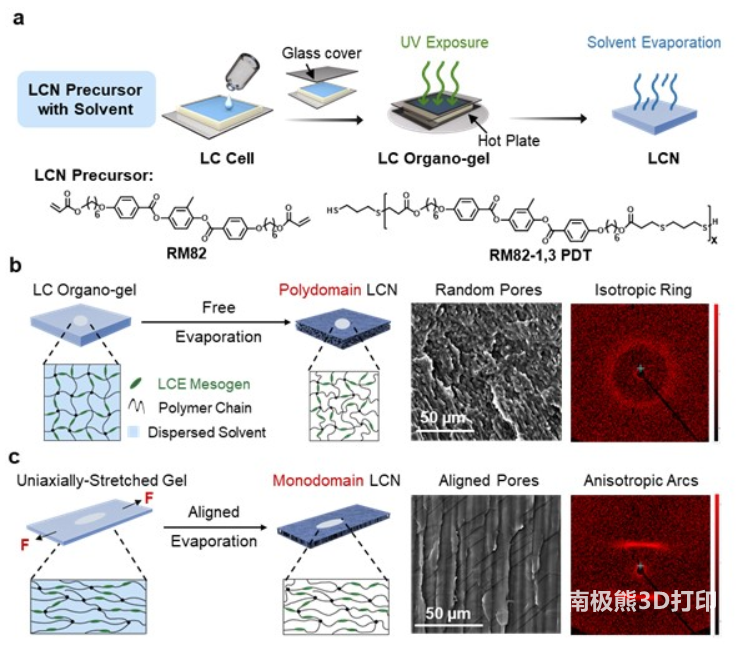
The controllability of the entropy driving method of LCN
In order to verify the controllability of the entropy driving method of LCN, this paper characterizes the driving performance of the film. As shown in Figure 2a, the uniaxially stretched and evaporated LCE film (applied stress, 43kPa) shows a reversible length change of approximately 100%, while the freely evaporated LCE film is heated above the anisotropic to isotropic transition temperature of 140 It is inactive at °C, which is measured by a differential scanning calorimeter (DSC). Dynamic mechanical analysis (DMA) further confirmed the stability of the entropy drive method (Figure 2b). Almost the same strain-temperature curve in repeated heating and cooling cycles indicates that the physically fixed mesogen arrangement is not disturbed by the time-dependent mesogen movement during the LC phase transition. In addition, this article also shows that the LCN drive has high flexibility.
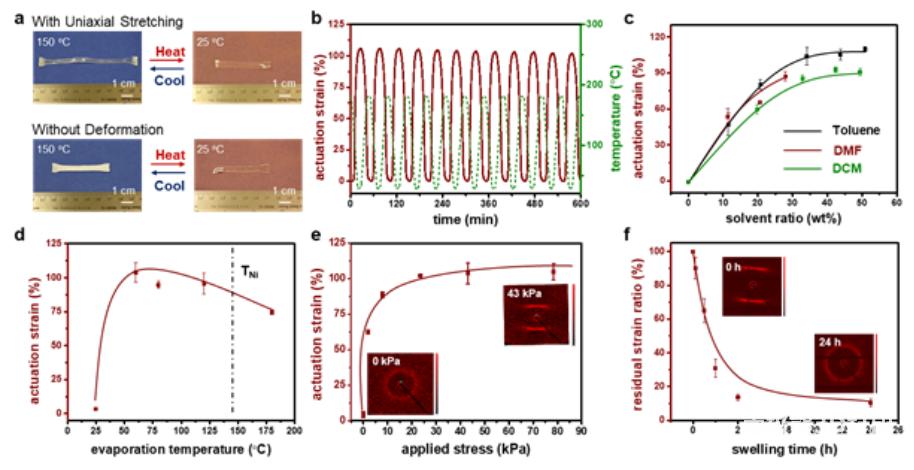
Multi-level erasing and reprogramming process of reversibly driven LCN
The ability to encode molecular arrangements in the initial gel through spatial deformation and solvent evaporation allows us to generate various nonlinear drive responses in a single film. As shown in Figure 3a, the original rectangular liquid crystal organogel can be easily programmed into three different 3D structures, and exhibit reversible driving behavior, including random bending, waving and twisting. Below the TNI, the shape is determined by the directional solvent evaporation, which can be erased and reprogrammed, and is referred to as a temporary shape in this article.Above TNI (for example, 150°C), the transformed shape is changed during network synthesis
Mould
Definition, we call it permanent shape. As shown in Figure 3b, the non-linear shape deformation behavior (between different temporary shapes and the same permanent shape) can be gradually achieved in a single film by repeated expansion and solvent volatilization and controlled deformation, where LC alignment and different temporary shapes It can be dynamically introduced, erased and reprogrammed according to specific application scenarios. For example, origami cranes (Figure 4a) and pyramids (Figure 4b) can be folded from a 2D sheet of organogel, and then stretched out when the solvent evaporates. When heated above TNI, the folded shape can be converted back to a 2D sheet .
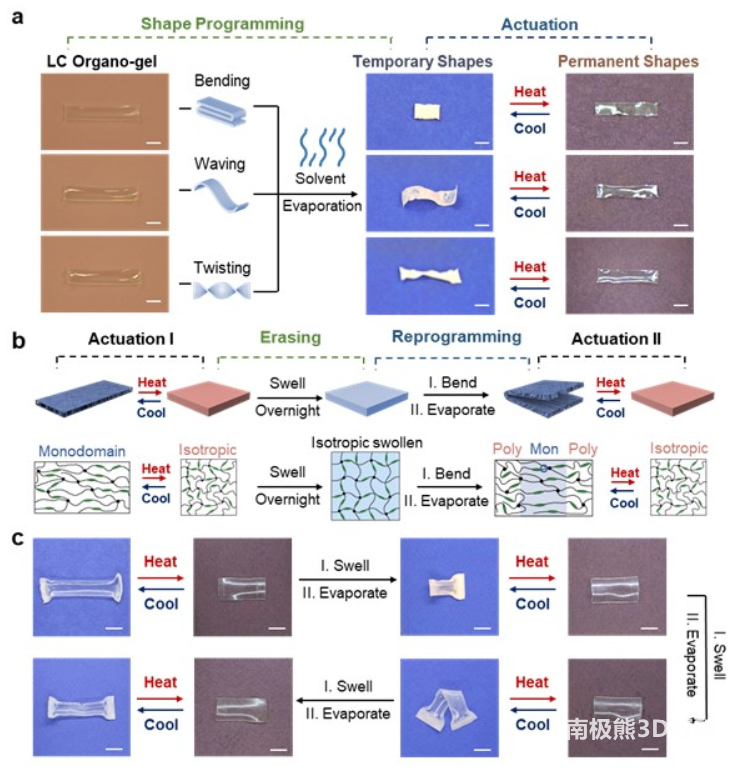
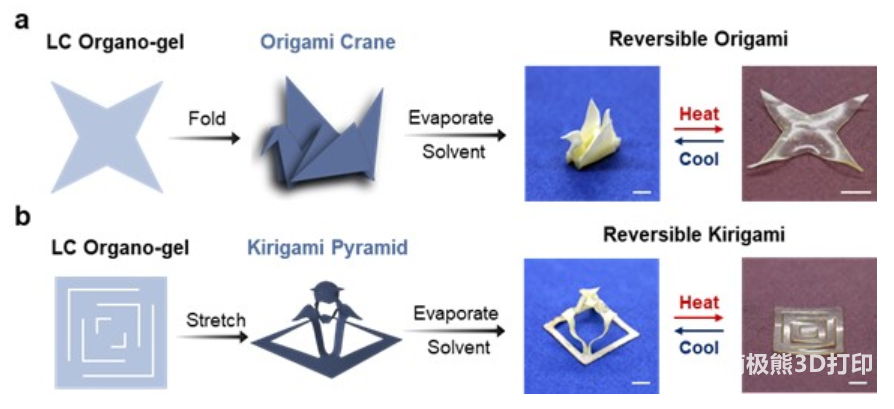
3D printingStructure and performance
use3D printingProcess The process of printing LCDs into complex geometries provides powerful tools for 4D programming.traditional3D printingThe structure of is not reprogrammable, and it is still challenging to build complex 3D structures layer by layer through this stacked cut method.On the contrary, the method in this article provides a new opportunity to first perform DLP on the LCN organogel3D printing, And then program the shape through deformation evaporation, as shown in Figure 5a.Although ethyl mercaptan is a commercial chain extender, it does not smell as unpleasant as PDT and is more user-friendly than PDT.3D printingThe open environment of the machine is very important.Therefore, EDDT is usually used for LCE3D printing. In addition, a high solvent mass fraction is critical to the success of printing. Through the method in this paper, a printing resolution of 129μm and a driving strain of 75% are achieved, which is much larger than the strain obtained from DIW printing LCE (usually 30-50%).
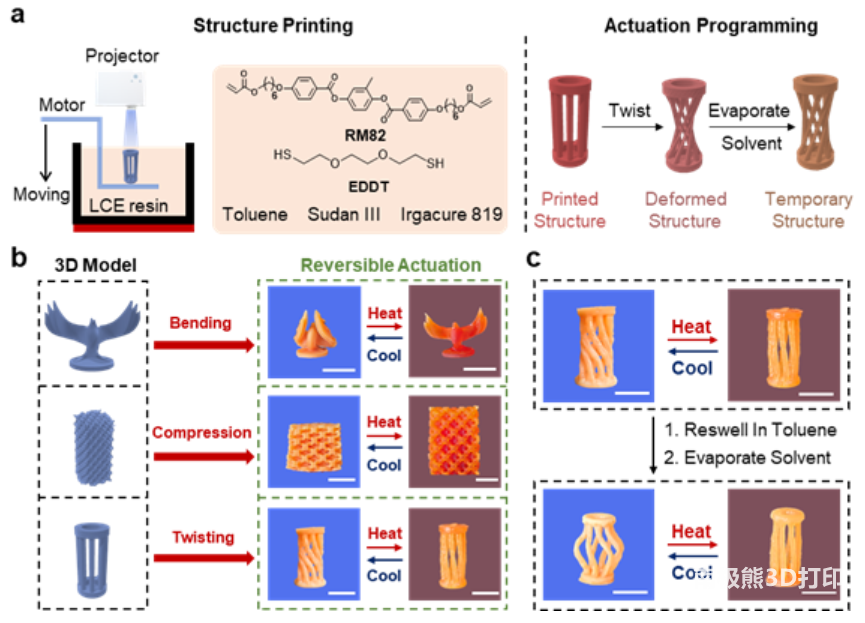
Summary: This article demonstrates the entropy control method of solvent-injected LCN organogel through decoupling network and ordering of liquid crystal mesogens. Therefore, by controlling the volatilization of the solvent in the isotropic organic gel under the action of stress, the deformed shape can be programmed, erased and reprogrammed at will. This article further demonstrates the compatibility of this method with origami structures and DLP printing to create complex temporary and permanent shapes in 4D, respectively. By relaxing the requirements on the rheological and mechanical properties of LCNs and precursors, the method in this paper can be easily applied to various LCNs to achieve good orientation and large driving strain in thick films. This will provide new opportunities for pattern programming of different types of LCNs in the same film.
picture
Full text link:
https://onlinelibrary.wiley.com/doi/10.1002/adma.202107855
(Editor in charge: admin)


0 Comments for “Professor Shu Yang AM from the University of Pennsylvania: 4D programming and reprogramming of liquid crystal network organogels”